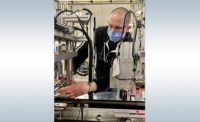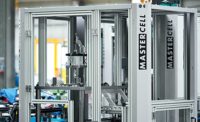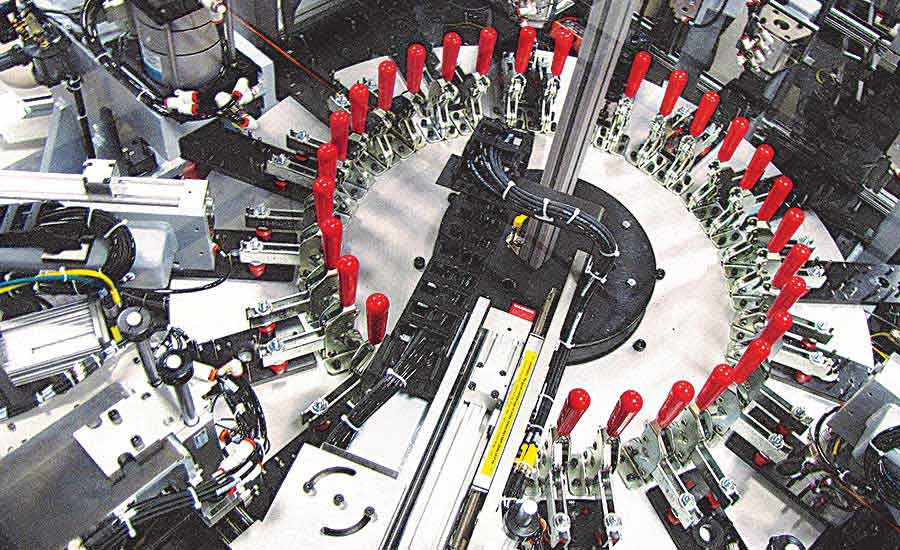Designing and Building Automated Assembly Systems
When designing automated assembly lines, integrators consider production volume, cost, delivery schedule and other factors




The first thing a visitor notices on arriving at the headquarters of Genesis Automation in St. Charles, IL, is the company’s business hours. Rather than 9 a.m. to 5 p.m., there’s this: “However long it takes.”
No mere slogan, the phrase reflects the realities of designing and building custom automation. Once a “request for quote” has been received, the process of creating an assembly system that meets the customer’s specifications is rarely straightforward. Part designs change. Processes are tweaked. The project scope widens.
“The first thing we ask when we get an RFQ is, ‘What is the endgame?’” notes Scott Hale, president of Genesis Automation. “Many times, we’re asked to design the machine before the product has been finalized. Or, a customer will ask us to automate ‘the low-hanging fruit,’ only to ask us later to automate additional processes. If we knew that up front, we could have saved the customer a lot of money.”
There are many ways to automate an assembly process: standalone cells combining manual and automated processes; synchronous systems based on rotary or linear indexers; and asynchronous systems based on pallet-transfer conveyors. Which way to go depends on such factors as production volume; cycle time; delivery timeline; budget; floor space; and product life cycle.
“If the customer wants ‘lights-out’ automation, that’s a whole different solution than if he’s willing to have six operators on the assembly line,” says Greg Hodge, senior applications engineer at ATC Automation. “In the latter case, we would use operators for processes that would be difficult or expensive to automate. We always look at cost—nobody has an unlimited budget.”
The biggest influence on system design is the product itself. How many parts are there? What do they look like? How many steps are needed to assemble them?
“It starts with the parts,” insists Rick Blake, president of Edgewater Automation. “The design of the system depends on what the product is, how fast it needs to be made, and what other parts go with it.”
Fast cycle times favor indexing assembly systems over power-and-free systems. Small products are ideal for rotary indexing dials. Larger ones are best assembled on linear systems. A product with relatively few parts can be economically assembled on a rotary indexer, while a large number of parts would point to a linear system.
Cycle time is a key factor. “We will take vastly different approaches depending on whether the customer needs to produce a product every two seconds or 35 seconds,” says Hodge.
An important consideration is whether the system will need to assemble a family of products.
“Most customers need to produce variations of the same product,” says Blake. “In fact, there are four projects on my desk now, and all of them need to produce more than one variation.”
The need to assemble variants typically favors a power-and-free system. If an assembly doesn’t need a particular part, it can simply bypass that station.
Outside Influences
While the product is the most important influence on line design, it’s not the only factor.
For example, the capabilities of the customer’s staff can make a difference. “You don’t want to design a big fully automated system for a customer that has only ever done manual assembly,” Hale points out.
Available floor space is another. An indexing dial can output a lot of product in a small footprint. A power-and-free system might be more flexible, but it also takes up a lot of space.
“We spend a lot of time with our customers mapping out what we call ‘environmental factors,’” says Kyle Spann, sales director for the welding group of Fori Automation. “What is their production schedule? How many shifts are they running? How many breaks are there? How much floor space do they have?
“From there, we can calculate cycle time based on the total volume of parts they need per year. And from that, we know that a given robot can produce so many welds or an operator can load so many parts.”
Delivery time can also influence system design. Being first to market with a new product can make a big difference in sales. As a result, manufacturers may prefer to automate a portion of the process just to get the system running sooner. Similarly, if an automation component has a long lead time, an integrator might choose an alternative component that can be implemented sooner.
Money matters, too. Power-and-free systems are more expensive than indexing systems. Manually loading parts at a station will be less expensive than a robot and a bowl feeder—at least initially.
“A lot depends on the customer’s expectation for return on investment,” says Todd Westfall, senior applications engineer at Invotec Automation. “If the customer will be making the product for several years, he may be able to justify the added investment.”
Price, performance and delivery often present competing challenges. Indeed, it’s not uncommon for integrators to present two approaches to the same RFQ. Open and honest dialogue is essential for resolving conflicts.
Assemblers should keep in mind that integrators cannot be expected to deliver a Cadillac at Chevrolet prices, so there’s little to be gained by being coy about their budgets. Some assemblers are tight-lipped about budgets, fearing that an integrator will design to a price rather than the task at hand. That’s a mistake, integrators say.
“Providing a little extra space on a rotary indexing dial to accommodate variants is less expensive than having to redesign the entire system later,” advises Hale.
Process Development
Once the basic layout has been decided, engineers must decide which processes to include and which to omit. Sometimes, that’s obvious. Some processes simply cannot be done manually. In other cases, processes are automated for ergonomic or safety reasons.
Speed can be a determining factor. “If you are trying to make a part every three seconds, there is just not a lot of time for an operator to complete a task,” Blake points out.
On the other hand, some processes are not amenable to automation. For example, people are better at handling fragile or flexible parts.
“We will often do feasibility studies to determine whether a process can be automated,” says Westfall. “If we’re 90 percent certain we can successfully automate a process, we’ll keep it in the system.”
Parts feeding often tops the list for process development. In that regard, Hale advises engineers not to “fight the part.”
“The goal is to guarantee 100-percent reliable feeding,” he says. “If that means the part leaves the feeder upside down, that’s OK. We can flip it later.”
Some assembly processes, such as screwdriving, are easily automated. Others require some engineering.
“In the past, our customers did most of the work on process development,” says Hale. “Today, they don’t have that expertise.”
That leaves integrators with a lot of work to do. In some cases, integrators may be unable to provide a quote on a project until they can figure out how to automate a particular process. A well-equipped integrator will have a machine shop and perhaps a 3D printer to produce low-cost, proof-of-concept tooling and even sample parts for assembly.
The principle of KISS—keep it simple, stupid—governs design in automated assembly systems. A pick-and-place operation can be done by linear actuators, a Cartesian robot, a SCARA or a six-axis arm. Which to choose depends on the work envelope and how many axes of motion the customer needs now—and in the future, explains Hodge.
Even after a machine has been built, engineers often need to tweak a process. Such was the case recently for Genesis Automation as it was finalizing an assembly system for an automotive component. The process called for eight plastic pins to be heat-staked simultaneously, recalls applications engineer Bernard Misiak. Outside the system, the staking station worked perfectly. But, once the station was integrated into the overall system, problems cropped up.
Careful analysis using temperature sensors and video cameras revealed that a draft was inadvertently cooling the pins, leading to inconsistent staking. Shielding the staking operation solved the problem.
Fori’s Spann knows the feeling. “You can engineer a system that works in your facility, but it can be a different story when you put it on the customer’s floor, and it’s working with real parts and real people,” he says. “You can’t simulate that.”
Having enough parts to debug a process is crucial. “A big issue in the automation industry now is a lack of parts to fully vet a machine,” says Hodge.
Of course, even the most reliable processes can fail. That’s why assembly systems are chockablock with sensors and test equipment. A basic pick-and-place operation will have several sensors: one to signal that a part is ready to be picked, another to signal that it has been picked up, and a third to ensure that the part has been placed correctly.
Successful inspection processes don’t happen by accident. They also require development. “A lot of people think a camera can do any kind of measurement or inspection,” says Westfall. “That’s not the case. We do a lot of experimenting with lighting and other factors to make sure the camera captures the information we want.”
Establishing Order
A product’s assembly plan affects both line design and process efficiency. While the order of operations may seem obvious, a product with multiple parts and subassemblies could be produced in a variety of layouts and assembly sequences.
For example, Genesis Automation recently worked with a customer that wanted to include a labeling operation in an automated assembly system. Initially, the customer believed the labeling operation should be at the end of the line, after the product had been fully assembled. As it turned out, it was easier to print and apply the label midway through the process to allow more accurate positioning of the label.
Data collection and traceability requirements can also influence the order of operations, says Hodge. The design of a system can depend on whether the customer simply wants a lot number for a batch of 10,000 assemblies or if he wants serial numbers on each subassembly or final assembly.
On an automotive welding line, the sequence of operations depends on what secondary operations need to be done, such as punching, grinding or dispensing, says Spann. In some cases, the sequence of operations may need to be altered to allow the parts to cool off. “Welding puts a tremendous amount of heat into the part, and that can cause distortion,” he explains. “You may need to vary the sequence of welds to minimize that distortion.”
Looking for a reprint of this article?
From high-res PDFs to custom plaques, order your copy today!









